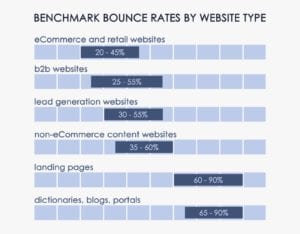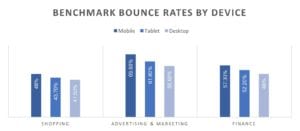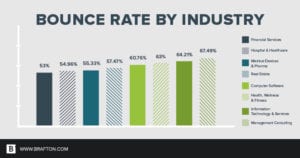Bounce rates.
This is a term that can either strike fear into the hearts of many or be the cause of much bragging. Thought of as a metric to measure a site’s success in reaching its target audience, it is not always clear what factors contribute to the final value.
In today’s post, we take a look at bounce rates and how different factors play into the final result.
What is a Bounce Rate?
According to Google Analytics, the term “bounce” means someone has visited a single page on your website and then left without doing anything further. By itself, this value is not a strong metric since it could mean many things.
To create a meaningful metric, you need to go one step further. A better calculation is to generate a percentage by dividing the number of single-page sessions by all sessions. This value is called a bounce rate.
Bounce rates can be applied to single webpages, sections of a website, or an entire website. This flexibility allows a website’s performance to be analyzed at its highest level or it can be drilled down to individual page performance.
The flexibility of bounce rates allows a website’s performance to be analyzed at its highest level or it can be drilled down to individual page performance. Click To Tweet
For those of us who are math challenged, don’t panic at the thought of having to do calculations. Google Analytics calculates the bounce rate for you. How great is that!
Bounce Rate Interpretations
Knowing a website’s bounce rate value is just the beginning in interpreting what this metric means. High bounce rates, for example, could mean that a site is in trouble or it could mean that everything is fine. It all depends on the nature of the website.
Let’s look at a few factors that can influence how a bounce rate can be interpreted.
Bounce Rates by Website Type
Bounce rates are not determined by a single variable, but by many. The type of website you have has a huge bearing on the type of bounce rates you can typically expect.
Take this chart, for example:

As you can see dictionary-type sites and blogs have a much higher bounce rate than e-commerce sites. Why is that?
Wikipedia is a free online encyclopedia. Often, visitors are interested in a single topic and may visit one page on Wikipedia to learn more. After they are done reading that webpage, they will leave the website. Through repeated use like this, Wikipedia’s bounce rate will be quite high. But does a high bounce rates signal trouble in this case? Absolutely not. It just means that visitors found the information they were looking for and moved on.
Conversely, let’s look at an online shoe retailer. The purpose of that website is to allow visitors to browse the shoe collections, then make a purchase. It’s hoped that visitors will navigate to multiple pages during their visit. If this website has a high bounce rate, it indicates that the website is not meeting the visitor’s expectations and they are leaving without looking around. Therefore, a high bounce rate would be bad in this case.
Bounce Rates by Device Type
Did you know that they type of device accessing your site can have an impact on your bounce rate?

What we can see by these graphs is that mobile users bounce more than those who access your site with other devices. This makes sense if you consider someone on their phone vs someone sitting at their desk. Mobile users are usually looking for some quick information or are distracted easily and move on to other tasks. This results in single page visits followed by a site exit. Additionally, sites not optimized for mobile use are frustrating and cause users to find alternative sites.
Desktop users, on the other hand, may have more time to invest in learning about the website. They may access multiple pages during a single site visit, thereby helping to reduce a site’s bounce rate.
Bounce Rate by Industry
Industry type also impacts a website’s bounce rate. Some industries lend themselves more to single-page views than others. Here is a quick industry breakdown to illustrate this point.

The variations between industries can be the result of both the common website structures used by different industries, and intent of its each industry’s users.
Industry standards for website structure can impact bounce rates. A medical clinic’s website, for example, may simply list the clinic’s hours, address and the doctors on call. Once a user has accessed the information on that page, they exit. Therefore, this type of industry will have a high bounce rate.
The nature of a real estate website is quite a bit different. This website is designed to give the user lots of different information. The visitor might click the “About Us” page to learn more about the realtor. Then they will click on the listings page to see what homes are available. Then they might navigate to the general information pages to learn more about buying and selling property. This industry encourages multiple page views, thus lowering the bounce rate.
Putting It All Together
Bounce rates are not a metric that should be feared. The value is important but should not be looked at in isolation. Examining the factors that influence a bounce rate is the only way to truly see if your site is in trouble.
The best advice is to treat the bounce rate as a benchmark. Figure out what you want your website to do, then put it into action. As you continue to work on your site, track how the changes impact the bounce rate. If the changes move this metric in the right direction, then you know you are on the path to success.
———-
In plain terms, WordPress (WP) is simply the top free platform upon which one can create
fantastic fully-featured websites or blogs of any size (best among both free or paid solutions).
Learn more about WordPress here.
***Gain more insight about how to install WordPress & your options.***
If you would like to consider working with us on our Premium or Standard Plans on a ongoing monthly basis, then we can do the job FREE as a trial (with no credit card required and assumes you have a interest potentially becoming a Standard or Premium Plan member . . . otherwise, please use the single one-off job option below).
See here: https://www.wpwebsitehelp.com/#plansandpricing
OR
2. If you only need us to do this one job only, then checkout here for this one-off single job.
See here: https://www.wpwebsitehelp.com/single-one-job/
Our plans can cover ongoing maintenance & annoying regular task items, of which, you should not spend your valuable time! This gives you peace of mind so you can focus your mind on your endeavor. We have you covered whether it is WordPress help or WordPress support for a business, personal, student, education, non-profit, or ministry endeavor.
Here are some examples along with HOW it works at WP Website Help.
Here are a few FAQ’s & our about us.
Jolene is a strong operations, compliance, and paralegal manager. She also loves to research and write about business as well as personal topics that help others.
Jolene @ The WP Website Help Team

